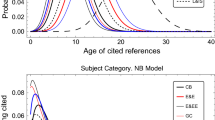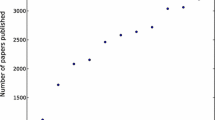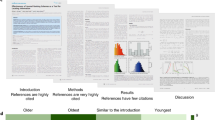Abstract
The cumulative distribution of the age of the most-recent-reference distribution is the “dual” variant of the first-citation distribution. The latter has been modelled in previous publications of different authors but the former one has not. This paper studies a model of this cumulative most-recent-reference distribution which is different from the first-citation distribution. This model is checked on JASIS and JACS data, with success. The model involves the determination of 3 parameters and is a transformation of the lognormal distribution. However we also show that the first-citation model (involving only 2 parameters and which is easier to handle), developed in an earlier paper, gives enough freedom to give close fits to the most-recent-reference data as well.
Similar content being viewed by others
References
Egghe L. (2000), A heuristic study of the first-citation distribution, Scientometrics 48 (3): 345-359.
Egghe L., Rao, I. K. R. (2001), Theory of first-citation distributions and applications, Mathematical and Computer Modelling, 34 (1-2): 81-90.
Egghe L., Rousseau R. (1990), Introduction to Informetrics. Quantitative Methods in Library, Documentation and Information Science. Elsevier, Amsterdam.
Egghe L., Rousseau R. (2000), The influence of publication delays on the observed aging distribution of scientific literature, Journal of the American Society for Information Science 51 (2): 158-165.
Gilbert N. (1997), A simulation of the structure of academic science, Sociological Research Online 2 (2), http://www.socresonline.org.uk/socresonline/2/2/3.html.
GlÄnzel W., Schubert A. (1990), The cumulative advantage function. A mathematical formulation based on conditional expectations and its application to scientometric distributions. In: Proceedings of the Second International Conference on Bibliometrics, Scientometrics and Informetrics London (Ontario, Canada), 1989 (L. Egghe, R. Rousseau (Eds)), 139-147.
Goldberg M. A. (1984), An Introduction to Probability Theory with Statistical Applications, Plenum Press, New York.
Gupta B. M., Rousseau R. (1999), Further investigations into the first-citation process: the case of population genetics, Libres 9(2), aztec.lib.utk.edu/libres/libre9n2/fc.htm.
Moed H. F., Van Raan A. F. J. (1986), Cross-field impact and impact delay of physics departments, Czechoslovak Journal of Physics B36: 97-100.
Rousseau R. (1994), Double exponential models for first-citation processes, Scientometrics 30 (1): 213-227.
Schubert A., GlÄnzel W. (1986), Mean response time — a new indicator of journal citation speed with application to physics journals, Czechoslovak Journal of Physics, B36: 121-125.
Sichel H. S. (1992), Note on a strong unimodal bibliometric size frequency distribution, Journal of the American Society for Information Science 43 (4): 299-303.
Stinson E. R. (1981), Diachronous versus Synchronous Study of Obsolescence. Ph. D. Thesis, University of Illinois.
Stinson E. R., Lancaster F. W. (1987), Synchronous versus diachronous methods in the measurement of obsolescence by citation studies, Journal of Information Science 13: 65-74.
Author information
Authors and Affiliations
Rights and permissions
About this article
Cite this article
Egghe, L., Ravichandra Rao, I.K.R. Theory and experimentation on the most-recent-reference distribution. Scientometrics 53, 371–387 (2002). https://doi.org/10.1023/A:1014825113328
Issue Date:
DOI: https://doi.org/10.1023/A:1014825113328




